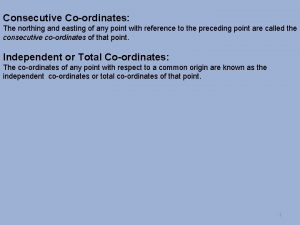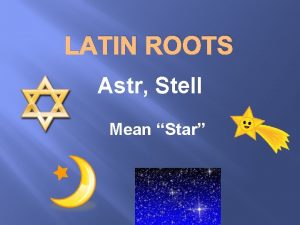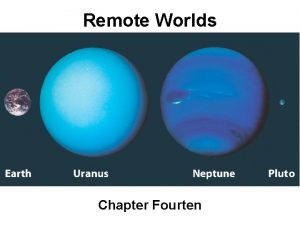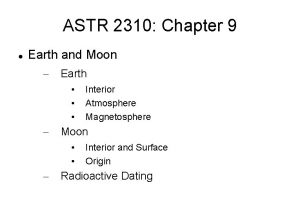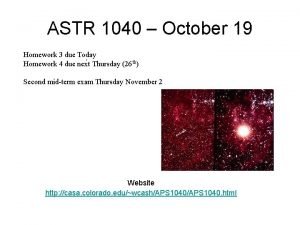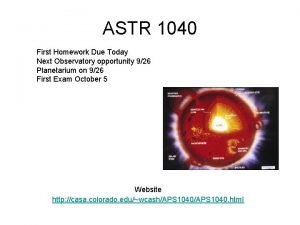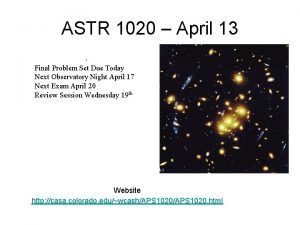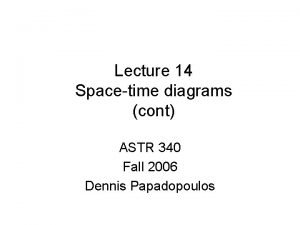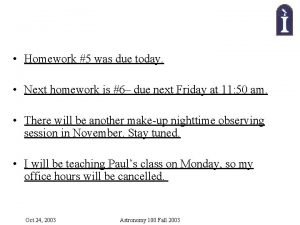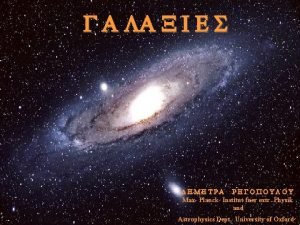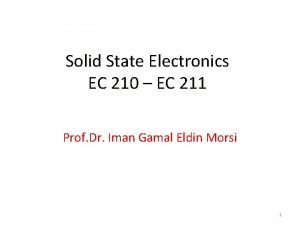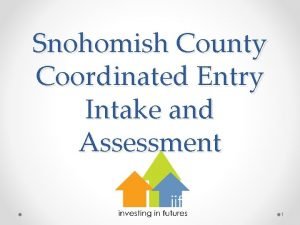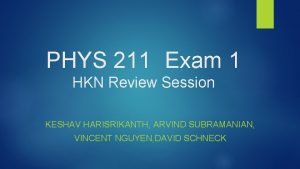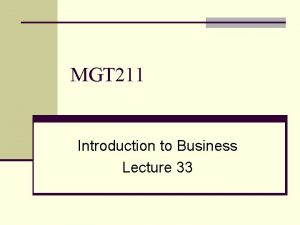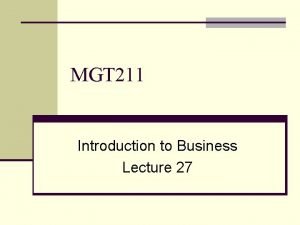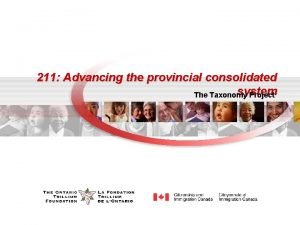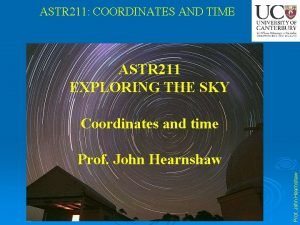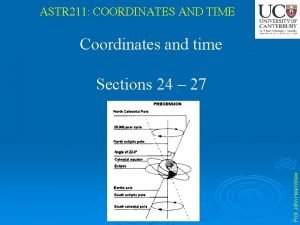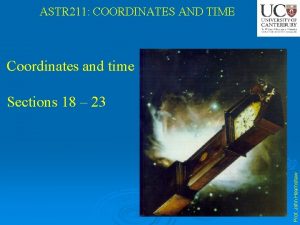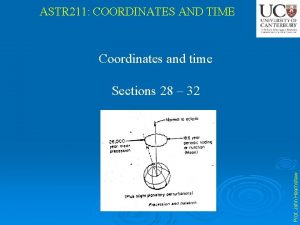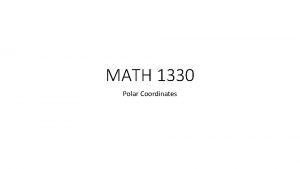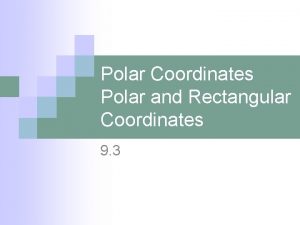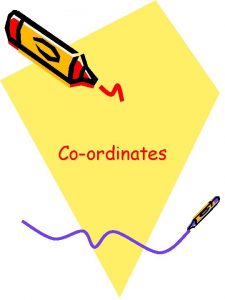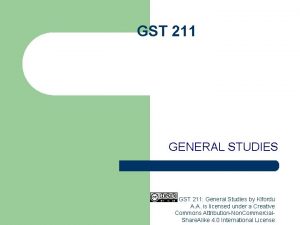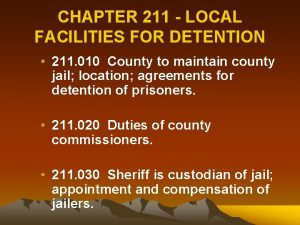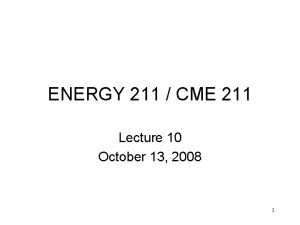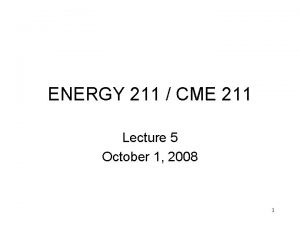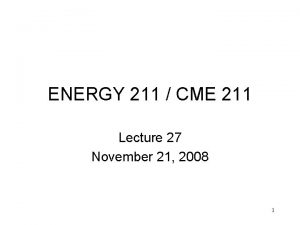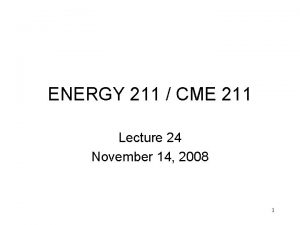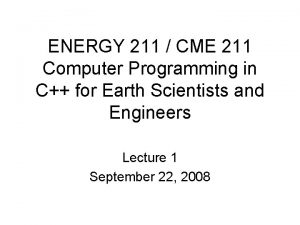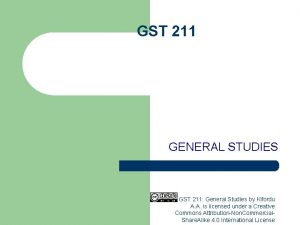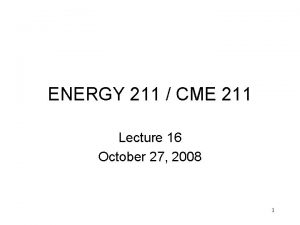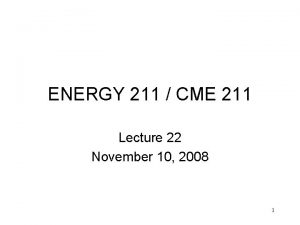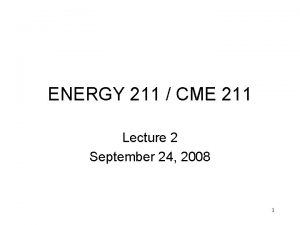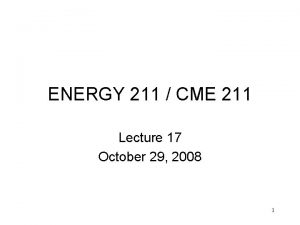ASTR 211 COORDINATES AND TIME Coordinates and time

































- Slides: 33

ASTR 211: COORDINATES AND TIME Coordinates and time Prof. John Hearnshaw Sections 9 – 17

ASTR 211: COORDINATES AND TIME 9. Declination of Sun = 0 at the equinoxes (Mar 21 ⊙ is at ; Sept 21 ⊙ is at ). Prof. John Hearnshaw ⊙ changes throughout the year between the limits = +23 27 at the June solstice, to = = 23 27 at the December solstice (respectively Jun 21, Dec 21)

ASTR 211: COORDINATES AND TIME ⊙ +23 27 Sep 21 Dec 21 Mar 21 Declination of Sun is sin ⊙ = sin ⊙ ⊙ ecliptic longitude of Sun ~ days elapsed since March equinox Prof. John Hearnshaw Mar 21 Jun 21

Prof. John Hearnshaw ASTR 211: COORDINATES AND TIME

ASTR 211: COORDINATES AND TIME 10. Altitude of Sun at culmination For N hemisphere observers a⊙ = 90 + ⊙ In S hemisphere a⊙ = 90 ⊙ In either case ⊙ may be >0 or <0. Prof. John Hearnshaw The Sun culminates at about noon (local time), at an altitude which depends on observer’s latitude and Sun’s declination.

ASTR 211: COORDINATES AND TIME Example: In Christchurch 43 32 S Altitude of noon Sun on Dec 21 is: Prof. John Hearnshaw a⊙ = 90 43 32 ( 23 27 ) 69 55

ASTR 211: COORDINATES AND TIME 11. Simple concepts of time-keeping The day Note that: 1. 1) Sun is itself moving along ecliptic at ~1 /day, 2. so Earth must turn about 361 in 24 hours, or 360 3. in 23 h 56 m Prof. John Hearnshaw This is approximately the time interval between two successive meridian passages of the Sun at a given location.

ASTR 211: COORDINATES AND TIME 2) The 1 /day increase in ecliptic longitude is not uniform (due to eccentricity of Earth’s orbit around Sun) Prof. John Hearnshaw 3) The rate of change of H for Sun depends on angle between ecliptic and parallels of declination.

ASTR 211: COORDINATES AND TIME 12. The equation of time The mean Sun: is a fictitious point on the equator that transits the meridian at equal time intervals – that is, its hour angle changes at a uniform rate. The mean and apparent Suns can differ in H by up to 16 m 20 s (on Nov 4) or ~4 in angular separation (in the right ascension coordinate). Prof. John Hearnshaw The apparent Sun: this is the actual or true position of the Sun. It is on the ecliptic.

ASTR 211: COORDINATES AND TIME The equation of time E is defined by E = H (apparent ⊙) – H (mean ⊙) Prof. John Hearnshaw The mean Sun is used to define mean solar time. In mean solar time the mean Sun transits across the observer’s meridian at noon (12 h) exactly.

ASTR 211: COORDINATES AND TIME The equation of time is a correction to apparent solar time (sundial time) to reduce it to mean solar time (in which all days have same length). App. solar time = mean solar time + E. Prof. John Hearnshaw If E is +ve, true Sun crosses meridian before mean Sun (ie. before noon). Sundial time is then ahead of mean solar time.

Prof. John Hearnshaw ASTR 211: COORDINATES AND TIME

Prof. John Hearnshaw ASTR 211: COORDINATES AND TIME

ASTR 211: COORDINATES AND TIME 13. The solar analemma Suppose the position of the Sun is recorded daily in equatorial coordinates (H, ), at the same mean solar time each day. While ⊙ will be given by its annual variation sin ⊙ = sin ⊙(t) Hence at any time of year t the solar coordinates describe a locus in sky (H, ) known as the solar analemma. Prof. John Hearnshaw At each date H⊙ will vary according to the equation of time H⊙ (apparent) = H⊙ (mean) + E (t)

ASTR 211: COORDINATES AND TIME Suppose a fixed camera photographs the sky at noon every day of the year so that all the images are superimposed on the same film. The different positions of the Sun throughout the year will describe a figureof-eight known as the solar analemma. Prof. John Hearnshaw The solar analemma

ASTR 211: COORDINATES AND TIME Prof. John Hearnshaw Solar analemma

ASTR 211: COORDINATES AND TIME Prof. John Hearnshaw Solar analemma and the equation of time

ASTR 211: COORDINATES AND TIME 14. The month One such cycle is a lunation or lunar month, equal to 29. 53 mean solar days. (Note: 1 year = 12. 37 lunar months. ) Prof. John Hearnshaw Based on cycle of lunar phases: New moon First quarter (no part of disk illuminated) Full moon Last quarter New moon (full disk illuminated)

ASTR 211: COORDINATES AND TIME 15. The Year Sun travels ~1 /day on ecliptic and so completes 360 in 365. 256 mean solar days. Prof. John Hearnshaw This interval is called the sidereal year as Sun is in same position relative to background stars after elapse of 1 sidereal year.

ASTR 211: COORDINATES AND TIME Time for successive passages of Sun through the vernal equinox ( ) is the tropical year = 365. 242 mean solar days. The difference between sidereal and tropical years amounts to 20 m 24 s. This phenomenon is termed precession of the equinoxes. Precessional period = 25, 800 years. Prof. John Hearnshaw The cause is the slow retrograde (westwards) motion of the First Point of Aries ( ) by 50. 2 arc s annually.

ASTR 211: COORDINATES AND TIME The sidereal year is the true orbital period of Earth. Prof. John Hearnshaw The tropical year is the length of one cycle of seasonal changes, and is in practice the year on which the civil calendar is based.

ASTR 211: COORDINATES AND TIME 16. The seasons (spring, summer, autumn, winter) Warmer climate in summer because: (i) longer hours of daylight (see section 23 d) (ii) higher altitude of Sun in sky means rays reach surface less obliquely greater insolation. (iii) Higher altitude of Sun in sky leads to less absorption in terrestrial atmosphere. Prof. John Hearnshaw These are determined by the right ascension and declination of the Sun, which depend on time of year as a result of obliquity of ecliptic (23 27 ).

The origin of the seasons Prof. John Hearnshaw ASTR 211: COORDINATES AND TIME

Diurnal paths of Sun at different seasons Prof. John Hearnshaw ASTR 211: COORDINATES AND TIME

Origin of the seasons Prof. John Hearnshaw ASTR 211: COORDINATES AND TIME

Solar illumination at different seasons Prof. John Hearnshaw ASTR 211: COORDINATES AND TIME

ASTR 211: COORDINATES AND TIME 17. Equatorial coordinate system (Part 2) The coordinates (right ascension, declination) (written R. A. , dec or , ) provide an equatorial system in which is fixed for each object (independent of time of observation, longitude). Prof. John Hearnshaw The system (hour angle, declination), or (H, ), has property that H for a given star depends on time of observation and on longitude of observer.

ASTR 211: COORDINATES AND TIME R. A. measured in h m s 360 24 h or 15 1 h or 1 4 m R. A. increases eastwards around equator (note H increases westwards). Because is (very nearly!) a fixed direction with respect to the stars, it follows that the coordinates ( , ) specify fixed directions in space relative to the stars. (This statement is approximate because of precession and because the stars are also in motion. ) Prof. John Hearnshaw R. A. = 0 h on meridian through the First Point of Aries, .

Prof. John Hearnshaw ASTR 211: COORDINATES AND TIME

ASTR 211: COORDINATES AND TIME Prof. John Hearnshaw End of sections 9 - 17

Prof. John Hearnshaw ASTR 211: COORDINATES AND TIME

Prof. John Hearnshaw ASTR 211: COORDINATES AND TIME

Prof. John Hearnshaw ASTR 211: COORDINATES AND TIME
 Consecutive coordinates in surveying
Consecutive coordinates in surveying Astr greek or latin
Astr greek or latin Trans neptunian objects
Trans neptunian objects 5-a-day language review week 8 answer key
5-a-day language review week 8 answer key Astr
Astr Astr
Astr Astr
Astr Astr
Astr Astr twins
Astr twins That was due today
That was due today Cronou
Cronou Dot product properties
Dot product properties Site:slidetodoc.com
Site:slidetodoc.com Opwekking 211
Opwekking 211 Miller indices 210
Miller indices 210 Coordinated entry snohomish county
Coordinated entry snohomish county Poli 211
Poli 211 Physics 211 exam 1
Physics 211 exam 1 Legea 211 2011
Legea 211 2011 Luyana211
Luyana211 A product can be
A product can be Is 211 nationwide
Is 211 nationwide Csce 211
Csce 211 211 la taxonomy
211 la taxonomy Trigo sy 211
Trigo sy 211 Csce 211
Csce 211 Comp 211
Comp 211 Comp 211
Comp 211 Comp 211
Comp 211 211 org md
211 org md Subplot 211 matlab
Subplot 211 matlab Nur 211 final exam
Nur 211 final exam Log 211
Log 211 Asoe model
Asoe model
